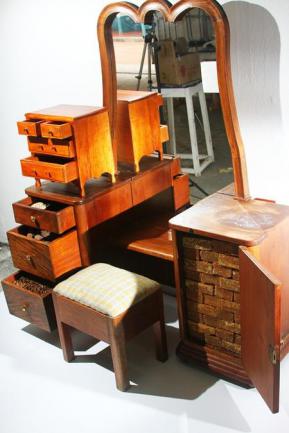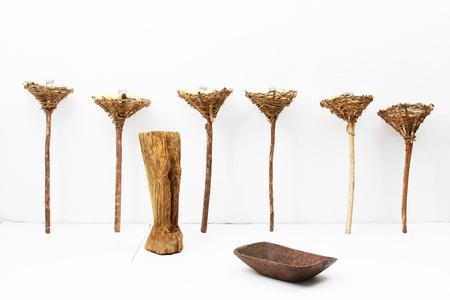
On display April 9 in Parque Santander. “I Come to Turn in my Heart” sits just below a towering statue of Francisco de Paula Santander, a leading figure in Colombia´s independence movement, in downtown Bogotá. Hundreds of Bogotanos were able to view the piece. Here we see a young man observing the vanity from afar as he decides whether or not to sit and listen to the testimonies of victims that play through a speaker attached to the piece´s mirror.

Victims created this piece from materials found in Montes de Maria. The piece contemplates the diversity of flora and fauna in Montes de Maria, and of daily farm life in which the nests, and products, of chickens and roosters play a sustaining role. The piece also touches on the irony of the name “Black Eagles”—the name of a reorganized paramilitary group in Colombia that has been responsible for acts of violence in the Montes de Maria region. Victims say the Black Eagles are one of many armed groups responsible for making violence as typical a part of daily life as tending to chickens and roosters once was. One victim who contributed to the construction of this piece noted, “Nests. That is where all is born in the countryside and that is where the Black Eagles now attack.”
“Three Nests” delicately stacked on a trash can in downtown Bogotá waiting to be put on display for Colombia´s first National Day of Victims. The piece accompanied ten other gallery pieces from the “We are Land” gallery displayed in front of Bogotá´s central Gold Museum and was framed by smaller galleries on exhibit by various victims organizations. The sign above the nests reads, “Bogotá belongs to all of us. Take care of it.” A survivor of the January 2001 Chengue, Sucre, massacre, in which paramilitaries of the Self Defense Forces of Colombia killed 27 people, helped to build the “Three Nests” piece. In reference to the gallery and to Colombia´s National Day of Victims he explained, “There is still conflict, it is a shame. But [with this gallery] we have brought to light things that have always been hidden . . . The idea is not to forget. Powerful people want us to forget, but we don´t want these violent acts to be repeated.” Testimonies have revealed that the Chengue massacre was carried out by the paramilitary group Self Defense Forces of Colombia under the command of Rodrigo Mercado Pelufo, alias “Cadena.” Prior to the massacre, citizens of Chenque officially requested protection from the Colombian state as they had received threats of violence. The town was left vulnerable to the attack in which nearly 80 paramilitaries tortured, murdered, and disappeared residents of Chengue.

A university student and two men on their way to work stop to view “The River of Tombs” in Bogotá´s Parque Santander.
Fresco Seated in front of the piece entitled “Fresco,” Francisco Bustamante of the Colombian non-governmental organization Minga explains the piece´s significance to members of the public gathered for Colombia´s National Day of Victims. His narration of the piece instigated a lively and impromptu debate between members of the public. It developed into a discussion on the roots of violence in Colombia and possible approaches to achieving peace. A play on words, the title refers to the Fresco style of painting while also evoking the Colombian term “fresco,” meaning fresh, or in colloquial speech, “cool” or relaxed. The title aims to question the relaxed and even indifferent attitude of a public inundated with images of, and information about, acts of violence in Colombia. The painting is a representation of the 1996 massacre near the town of La Gabarra where members of the Fuerzas Armadas Revolucionarias de Colombia (FARC) guerilla group killed an estimated 35 young men known as “raspachinos”—hired hands to harvest and help process coca leaves. According to survivors’ testimonies, the victims’ hands were tied behind their backs and each were shot while accused by the FARC of being members of the paramilitary groups that controlled coca production in La Gabarra. Text accompanying the piece reads “These are the ‘raspachinos’ murdered by the FARC . . . boys just like the boys who killed them; boys that will never return to the dance of life; dead boys whose bodies, so far from life, rot in the heat . . . where the stake of hate burns.”
Sustenance for Whom? / ¿El sustento para quién? The Renault 12 is an emblematic car in Catatumbo. There, self-employed drivers have used this model for years to transport people and food such as bananas, rice, and yucca. This gallery piece, a life-sized Renault filled with the branches and the fruit of African Palm plants, is a homage to both the car and its drivers who are exposed to great risks as they travel through territory plagued by conflict and controlled by illegal armed groups. Text accompanying this piece explains, “The [drivers] risk their lives each day to transport the goods that sustain rural life, and to earn enough money to sustain themselves in a country with limited [employment] opportunities . . . [ this piece is also for] the drivers . . . who have been murdered while trying to transport food to their own families.” “Sustenance for Whom?” also calls into question the emphasis on African Palm as a viable crop for rural Colombia. Many communities have been forcibly displaced from their land to make way for the planting of African Palm, a non-food crop, and many campesinos believe African Palm plantations will ultimately destroy more sustainable agriculture crops and practices. The Renault on display in Bogotá.
Annalise Udall Romoser is based in Bogotá, Colombia, and is the Lutheran World Relief´s Communications Officer for Latin America. Thank you to the organizations Minga, Agenda Caribe, and the Manuel Cepeda Foundations for contributing text and photos. Translations by Annalise Udall Romoser.

